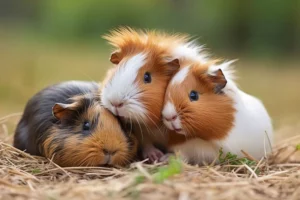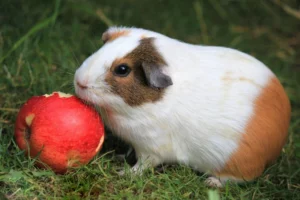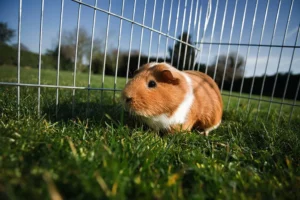As they scurry and squeak around their enclosures, it’s only natural for pet owners to wonder: When do guinea pigs stop growing?
Guinea pigs, those delightful and social little rodents, are a popular choice as pets for many animal lovers.
Understanding the growth patterns of these charming creatures is crucial for providing them with proper care and ensuring their well-being.
In this comprehensive guide, we’ll explore the various aspects of guinea pig growth, from their initial size to factors influencing their development.
When Do Guinea Pigs Stop Growing?

Guinea pigs typically reach their full size by the time they are 6 to 12 months old.
However, the exact timing can vary among individuals and is influenced by factors such as genetics, diet, and overall health.
Some guinea pigs may stop growing as early as 6 months, while others might continue to develop until they are a year old.
Understanding the growth timeline can help pet owners better gauge their guinea pig’s development.
During the first few weeks of life, guinea pigs experience rapid growth, doubling or even tripling in size.
As they enter adolescence, the growth rate slows, and by the age of six months, many guinea pigs have reached their mature size.
However, it’s important to note that individual differences exist, and some guinea pigs may continue to grow slightly beyond this timeframe.
How Big Do Guinea Pigs Get?

The size of a guinea pig largely depends on its breed. On average, guinea pigs range from 8 to 12 inches (20 to 30 cm) in length.
Popular breeds like the American guinea pig tend to be on the larger side, while smaller breeds like the Abyssinian may be more petite.
Additionally, factors such as diet and environment can play a role in determining a guinea pig’s size.
It’s fascinating to observe the variety in size among different breeds.
American guinea pigs, known for their sleek and smooth coat, typically reach the larger end of the size spectrum.
In contrast, Abyssinian guinea pigs, with their distinctive rosettes, often have a more compact and petite stature.
Understanding the typical size range for your guinea pig’s breed can give you insights into what to expect as they grow.
How big can baby guinea pigs get?
Newborn guinea pigs, also known as pups, are incredibly tiny.
At birth, they typically weigh between 2.5 to 4 ounces (70 to 115 grams) and are about 3 to 4 inches (7.6 to 10 cm) long.
As they grow, their size increases rapidly, and they go through several developmental stages.

The early weeks of a guinea pig’s life are crucial for their development. During this time, they are highly dependent on their mother’s milk for essential nutrients.
It’s not uncommon for a pup’s weight to double within the first week, showcasing the remarkable growth potential of these small rodents.
Providing a warm and secure environment, along with the mother’s care, is vital to ensuring the healthy development of baby guinea pigs.
What is the growth rate of guinea pigs?

The growth rate of guinea pigs is most significant during their early weeks of life.
During this time, they can gain up to 1 ounce (28 grams) per week.
This rapid growth gradually slows down as they approach adulthood. It’s essential to provide them with a balanced diet during this crucial period to ensure proper development.
Understanding the growth rate of guinea pigs sheds light on their unique developmental needs.
The first four weeks mark a period of rapid growth, with guinea pigs doubling or even tripling their birth weight.
As they transition to a solid diet and become more independent, the growth rate becomes steadier.
This gradual decrease in growth rate emphasizes the importance of a nutrient-rich diet throughout their lives, ensuring they receive the necessary vitamins and minerals for overall well-being.
What factors affect the size of a guinea pig?
Several factors can influence the size of a guinea pig:

- Genetics: The breed and genetics of a guinea pig play a significant role in determining its size. Some breeds are naturally larger than others.
- Diet: A well-balanced and nutritious diet is crucial for healthy growth. Ensure your guinea pig has access to fresh hay, vegetables, and a high-quality guinea pig pellet.
- Environment: The living conditions and space provided can affect a guinea pig’s overall well-being, which in turn can impact its growth.
- Health: Regular veterinary check-ups are essential to monitor your guinea pig’s health. Any underlying health issues can potentially affect its growth.
Understanding these factors allows pet owners to make informed decisions about their guinea pig’s care.
By providing a suitable environment, a balanced diet, and regular veterinary attention, you contribute to the overall health and well-being of your furry companion.
Understanding the typical growth milestones of guinea pigs can be helpful for pet owners. Here’s a general growth chart based on age:
- Newborn (0-1 week): 2.5 to 4 ounces, 3 to 4 inches
- 2 weeks: 4 to 6 ounces, 4 to 5 inches
- 4 weeks: 8 to 12 ounces, 5 to 6 inches
- 8 weeks: 12 to 16 ounces, 6 to 7 inches
- 12 weeks: 16 to 24 ounces, 7 to 8 inches
- 16 weeks: 24 to 32 ounces, 8 to 9 inches
- 20 weeks: 32 to 40 ounces, 9 to 10 inches
- 6 months (24 weeks): Full size reached for many guinea pigs
Tracking your guinea pig’s growth through these milestones provides valuable insights into their development.
Keep in mind that individual variations exist, and the provided values are general guidelines.
Regularly measuring and weighing your guinea pig can help ensure they are on track with their growth and development.

How do I ensure my guinea pigs reach their full-size potential?
Ensuring your guinea pigs reach their full size potential involves a combination of proper care, nutrition, and environment:

- Balanced diet: Provide a diet rich in fresh hay, high-quality pellets, and a variety of fresh vegetables. Avoid excessive amounts of sugary treats.
- Adequate space: Guinea pigs need ample space to move around. A spacious cage with hiding spots and toys promotes physical activity and mental stimulation.
- Regular veterinary check-ups: Schedule regular check-ups with a veterinarian to monitor your guinea pig’s health and address any potential issues promptly.
- Social interaction: Guinea pigs are social animals, and interaction with their human companions or other guinea pigs is essential for their well-being.
- Clean environment: Maintain a clean living environment by regularly cleaning the cage, providing fresh bedding, and ensuring proper ventilation.
By incorporating these elements into your guinea pig’s daily life, you contribute to their overall happiness and well-being.
Remember that each guinea pig is unique, so paying attention to their individual preferences and needs is key to ensuring they reach their full size potential.
Frequently Asked Questions (FAQs)
Here are some common questions related to guinea pig size:
1. Can I predict the adult size of my guinea pig based on its breed?
While certain breeds tend to be larger or smaller, individual variations within breeds make it challenging to predict the exact size of a guinea pig.
Factors such as genetics and overall health also play a significant role.
2. Are there growth differences between male and female guinea pigs?
In general, there isn’t a significant size difference between male and female guinea pigs of the same breed.
However, individual variations exist, and factors such as genetics and diet play a role in determining their size.
3. Do guinea pigs continue to gain weight after reaching their full size?
While guinea pigs may continue to gain a small amount of weight as they age, significant growth typically ceases once they reach their full size.
Monitoring their weight through regular weigh-ins can help ensure they maintain a healthy size.
4. Can an improper diet stunt a guinea pig’s growth?
Yes, a lack of proper nutrition can negatively impact a guinea pig’s growth and overall health.
Ensure a balanced diet with adequate hay, pellets, and fresh vegetables.
Avoid overfeeding and limit the intake of high-sugar or high-calcium foods.
Final Thoughts:
Understanding when guinea pigs stop growing and the factors influencing their size is crucial for providing optimal care.
By offering a balanced diet, a clean environment, regular veterinary check-ups, and opportunities for social interaction, you can ensure that your guinea pigs reach their full size potential and lead happy, healthy lives.
Keep in mind that individual variations exist, and each guinea pig is unique, requiring personalized attention and care.
By being attuned to their needs, you’ll build a strong bond with your furry companions that lasts a lifetime.



